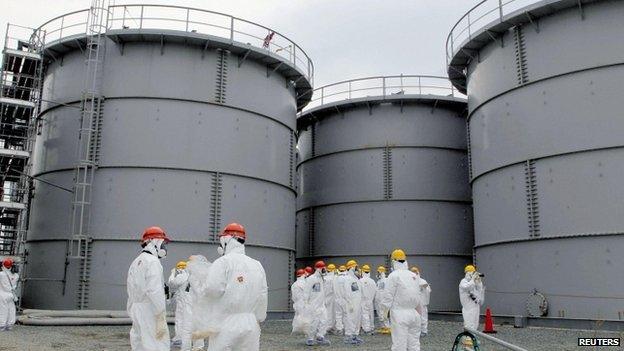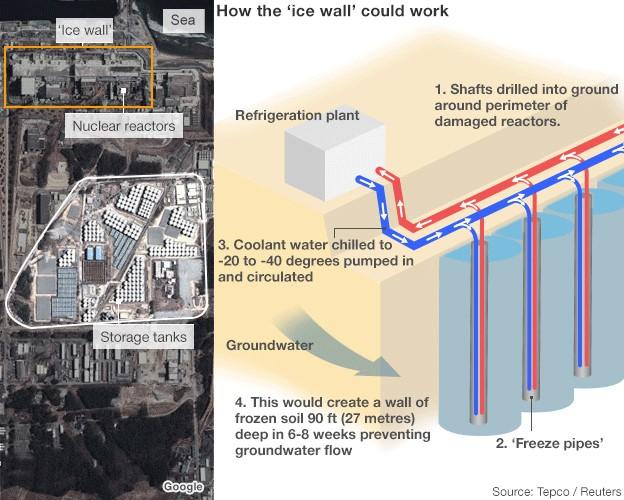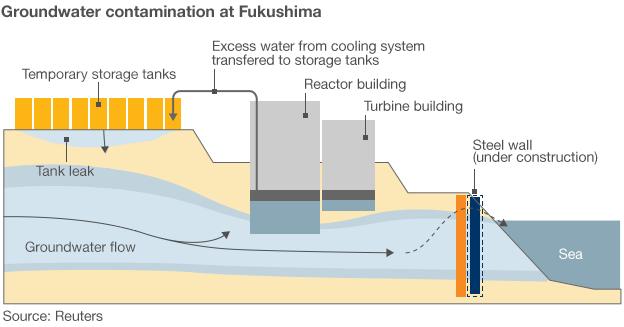Q&A: Fukushima leak problems
- Published

The Fukushima Daiichi site is now populated by large numbers of storage tanks
Workers at the damaged Fukushima nuclear power facility in Japan have to deal with huge volumes of contaminated water. The difficulties of handling this water, some of which has leaked from storage tanks, has prompted the authorities to consider measures such as an "ice wall" to better contain the area around the troublesome plant.
What is the cause of the continuing leak problems at the plant?
The ongoing problem with water seems to be coming, in the main, from poorly constructed storage tanks. Tepco, the company that operates Fukushima, is using huge volumes of water every day to cool the reactors that once generated electricity at the plant. When the water comes in contact with fuel rods at the heart of the reactors, it becomes highly radioactive and has to be stored in large containers on the site where the water is then processed to remove some of the most dangerous elements.
Every day, the company has an extra 400 tonnes of irradiated water to store. This is roughly a 10th of an Olympic-sized swimming pool. The water is held in some of the 1,000 water tanks the company has erected on site. But there are problems with these tanks. There have been at least five leak events from the tanks, with the most recent, in August, being the largest. This saw contaminated water flood a walled concrete pad under the faulty tank, and then pass through a rainwater valve to soak the surrounding soil.
Officials say the problem may have been related to the fact that the tank was moved after its original installation at the site and was not reassembled properly, and/or that its plastic seals became damaged in the process. Tepco workers have since been trying to clean up the spilled water and remove any contaminated soil.
How dangerous are the levels of radioactivity?
Having initially reported high levels of radiation - of about 100 milliSieverts per hour near the leaked water within the moat - officials had to concede later that the equipment used to take the readings had an inadequate scale. When newer equipment was brought in, it was established that the levels of beta radiation had actually been 18 times higher. Subsequent readings have been up to as much as 2,200mSv per hour. While still extremely high, experts say that, properly protected, workers can still operate in such an environment.
"What is vital is whether this is beta or gamma radiation; the Japanese nuclear watchdog has said the radiation is beta," says Prof Paddy Regan, at the University of Surrey, UK. "Workers can get close to the source of beta radiation without a significant radiological hazard, because the beta particles lose their energy in the air (radioactivity lost after about 10cm) and assuming the source is not airborne. As long as the radioactive particles are not deposited on the skin, inhaled or ingested, the hazard is much smaller than if the radiation had been for a whole body gamma ray exposure of the same dose."
And although the public understandably finds any talk of radioactivity alarming, the overall emissions at Fukushima need to be kept in some perspective. According to Dr Ken Buesseler, senior scientist at the Woods Hole Oceanographic Institution, US, the release of the radioactive element caesium from Fukushima, for example, is between a 10th and a third of what was released from the accident in Chernobyl, and perhaps one fortieth of what was released by the hundreds atmospheric nuclear bomb tests in the last century.
How does Fukushima's location exacerbate the water problems?
There are steep hills behind the Fukushima plant. Rainwater runs down from those hills, through the ground on which the plant is built and out into the ocean. Radioactivity readings offshore have not fallen in the way many experts say they should have, indicating that this groundwater is picking up radioactive elements on its journey. Tepco is working on a series of plans to stop more radioactive water getting into the ocean, including erecting steel barriers and injecting chemicals into the earth to create an impermeable layer.

What is the ice wall that is being proposed?
This is the latest solution being proposed. It involves running pipes through the affected ground, and pumping coolant through them. "This causes the local groundwater to freeze, forming a barrier to the movement of contaminated ground water," explains Prof Neil Hyatt from the University of Sheffield, UK. "A similar process is used in underground uranium mining, to prevent flooding of a working area at depth, so the basic engineering principles are quite well understood. However, this is a very energy intensive process to maintain, so there will need to be careful design and trial work to produce an effective barrier that minimises energy demand."
What are the timescales involved?
Some commentators say such a solution will take years to put in place properly, and even then may not be totally effective. There is uncertainty, also, about how a network of thin pipes will cope in the event of another big accident. And Dr Komei Hosokawa from Kyoto Seika University, Japan, warns that in some respects, the ice wall idea could make matters worse: "Underground ice walls surrounding the reactor basement may work as neutron reflectors, which might make an easier condition for the melted fuel debris to go back to criticality (i.e. chain reaction), [but] blocking influx of groundwater would lower the aquifers around the reactor basement, which would result in seepage of more, highly radioactive water out of the reactor buildings. So far, the groundwater influx has had a diluting effect, although the volume of tainted water has increased."
What is the eventual solution to the stored water issue?
Tepco has changed its inspection protocols for the storage tanks and claims this should pick up any future problems much earlier. But given the huge volumes of water being handled at the site, it is likely that Tepco will have to introduce bigger, more robust storage tanks at some point - similar in scale to the crude oil depot tanks for which there is good local technology in Japan. The water itself needs to be filtered, to take out the most radioactive elements. This "cleaned" water is likely then to go into the Pacific. Even before then, such is the volume of contaminated cooling water coming out of the reactors that Tepco may be forced simply to release some water unfiltered into the ocean.

Water from the storage tanks has seeped into the groundwater and then into the sea. Efforts to use a chemical barrier to prevent sea contamination have not worked.